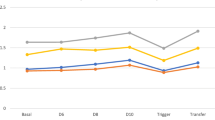Abstract
Purpose
To detect whether ultrasonographic parameters and Doppler analysis of uterine blood flow can be of value in the prediction of endometrial receptivity in infertile female patients undergoing embryo transfer.
Methods
In this study, a total of 200 women with primary infertility undergoing embryo transfer were analyzed. Transvaginal ultrasonography was done on the 10th day of the menstrual cycle. To assess the uterine receptivity, we analyzed all the ultrasonographic and Doppler parameters. The slightly modified version of Applebaum Uterine Scoring System was used. This uterine scoring system included all the following parameters: endometrial thickness, endometrial morphology, endometrial blood flow within zone 3, myometrial echogenecity, uterine artery pulsatility index (PI), end diastolic blood flow, and myometrial blood flow internal to the arcuate vessels seen on gray-scale examination.
Results
The pregnancy rates were higher in women with thick, distinct five-line endometrium and multifocal endometrial vascularity within zone 3. Absent endometrial flow, despite highest values for the other parameters, was associated with no conception. In our study, no pregnancy occurred with uterine PI values of more than 2.8. Absence or reversal of end diastolic blood flow was associated with no conception. A maximum score of 20 was associated with the pregnancy rate of 97.4 %, whereas scores of 13 or less resulted in no pregnancies.
Conclusion
Uterine scoring system will help to perform embryo transfers in only favorable uteri and postpone or cancel those cycles in which poor uterine score is demonstrated.




Similar content being viewed by others
References
Gnoth C, Godehardt E, Frank-Herrmann P, et al. Definition and prevalence of subfertility and infertility. Hum Reprod. 2005;20(5):1144–7. doi:10.1093/humrep/deh870.
Applebaum M. The uterine biophysical profile. Ultrasound Obstet Gynecol. 1995;5(1):67–8.
Noyes N, Hampton BS, Berkeley A, et al. Factors useful in predicting the success of oocyte donation: a 3-year retrospective analysis. Fertil Steril. 2001;76(1):92–7.
Kovacs P, Matyas S, Boda K, et al. The effect of endometrial thickness on IVF/ICSI outcome. Hum Reprod. 2003;18(11):2337–41.
Okohue JE, Onuh SO, Ebeigbe P, et al. The effect of endometrial thickness on in vitro fertilization (IVF)-embryo transfer/intracytoplasmic sperm injection (ICSI) outcome. Afr J Reprod Health. 2009;13(1):113–21.
Casper RF. It’s time to pay attention to the endometrium. Fertil Steril. 2011;96(3):519–21. doi:10.1016/j.fertnstert.2011.07.1096.
Zhang X, Chen CH, Confino E, et al. Increased endometrial thickness is associated with improved treatment outcome for selected patients undergoing in vitro fertilization-embryo transfer. Fertil Steril. 2005;83(2):336–40.
Merc LT, Barco MJ, Bau S. 2D and 3D power Doppler ultrasound of endometrium as implantation marker. Donald Sch J Ultrasound Obstet Gynecol. 2008;2(2):1–11. doi:10.5005/jp-journals-10009-1052.
Zhao J, Zhang Q, Li Y. The effect of endometrial thickness and pattern measured by ultrasonography on pregnancy outcomes during IVF-ET cycles. Reprod Biol Endocrinol. 2012;28(10):100. doi:10.1186/1477-7827-10-100.
Ng EH, Chan CC, Tang OS, et al. Endometrial and subendometrial vascularity is higher in pregnant patients with livebirth following ART than in those who suffer a miscarriage. Hum Reprod. 2007;22(4):1134–41.
Wang L, Qiao J, Li R, et al. Role of endometrial blood flow assessment with color Doppler energy in predicting pregnancy outcome of IVF-ET cycles. Reprod Biol Endocrinol. 2010;18(8):122. doi:10.1186/1477-7827-8-122.
Malhotra N, Malhotra J, Malhotra N, et al. Endometrial receptivity and scoring for prediction of implantation and newer markers. Donald Sch J Ultrasound Obstet Gynecol. 2010;4(4):439–46.
Chien LW, Au HK, Chen PL, et al. Assessment of uterine receptivity by the endometrial-subendometrial blood flow distribution pattern in women undergoing in vitro fertilization embryo transfer. Fertil Steril. 2002;78(2):245–51.
Bhadauriaa K, Sahnib R, Vermab S, et al. Colour Doppler ultrasound in controlled ovarian stimulation with intrauterine insemination. Apollo Med J. 2012;9(3):252–62.
Maugey-Laulon B, Commenges-Ducos M, Jullien V, et al. Endometrial vascularity and ongoing pregnancy after IVF. Eur J Obstet Gynecol Reprod Biol. 2002;104(2):137–43.
Tekay A, Martikainen H, Jouppilas P. The clinical value of transvaginal colour Doppler ultrasound in assisted reproductive technology procedures. Hum Reprod. 1996;11(8):1589–91.
Dechaund H, Bessueille E, Bousquet PJ, et al. Optimal timing of ultrasonographic and Doppler evaluation of uterine receptivity to implantation. Reprod Biomed Online. 2008;16(3):368–75.
Author information
Authors and Affiliations
Corresponding author
Ethics declarations
Conflict of interest
The authors declare that there is no conflict of interest.
Ethical approval
All procedures followed were in accordance with the ethical standards of the responsible committee on human experimentation (institutional and national) and with the Helsinki Declaration of 1975, as revised in 2008 (5).
Informed consent
Informed consent was obtained from all patients for being included in the study.
Additional information
Dr. Mohd Shoeb Khan is Director and Embryologist in Aneesa Infertility Centre, Navi Mumbai. Dr. Aneesa Shaikh is a sonologist in Aneesa Infertility Centre, Navi Mumbai. Dr. Rekha Ratnani is an infertility specialist in Apollo BSR Hospital, Bhilai.
Rights and permissions
About this article
Cite this article
Khan, M.S., Shaikh, A. & Ratnani, R. Ultrasonography and Doppler Study to Predict Uterine Receptivity in Infertile Patients Undergoing Embryo Transfer. J Obstet Gynecol India 66 (Suppl 1), 377–382 (2016). https://doi.org/10.1007/s13224-015-0742-5
Received:
Accepted:
Published:
Issue Date:
DOI: https://doi.org/10.1007/s13224-015-0742-5




